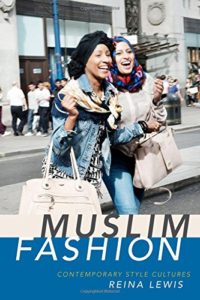

Muslim Fashion: Contemporary Style Cultures is Reina Lewis’s latest contribution to the critical literature emerging at the intersection of fashion studies and Islamic studies (Jones 2007; Moors and Tarlo 2013; Tarlo 2010). Reflecting the primary approach that characterizes Islamic fashion studies, the book argues that “Muslim fashion needs to be taken seriously as fashion” (Lewis 2015, 3). For this purpose, the author combines innovative archival research with multi-sited ethnography to analyze the growing Islamic fashion market and how Muslim individuals, particularly young women, engage with fashion as they negotiate the politics of identity and belonging.
Muslim Fashion’s primary sites are Britain, North America, and Turkey. Acknowledging that multiple fashion systems exist contemporaneously, the book studies sites of retail, fashion magazines and catalogues, and digital media practices to analyze Muslim fashion systems within their broader geopolitical contexts. This approach allows Lewis’s comprehensive study to demonstrate how Islamic sartorial codes are reinterpreted and negotiated, and how Muslim bodies gain new meanings at the confluence of local, national, and global political tensions.
This approach allows Lewis’s comprehensive study to demonstrate how Islamic sartorial codes are reinterpreted and negotiated, and how Muslim bodies gain new meanings at the confluence of local, national, and global political tensions.
Avoiding reductive categorizations such as “the Islamic world” or “the Muslim dress,” the book acknowledges the diversity that defines Islamic belief systems as well as the everyday experience of Islam and practices of embodiment. In-depth interviews with consumers and fashion professionals on different levels—from retail assistants to leading designers, entrepreneurs, and journalists—reveal the complex processes of design, retail, promotion, and consumption that define Muslim fashion systems. The book thus provides important insights into a growing segment of the fashion industry while also demonstrating the role of fashion in identity practices.
In order to analyze Muslim fashion systems, the book presents a diverse array of case studies, such as the development of Islamic fashion brands, Muslim lifestyle magazines, and new media practices. While the chapters complement one another, each of them can also be read separately. Following a comprehensive introduction, the first chapter of Muslim Fashion provides the background for Lewis’s study, situating Islamic consumer cultures within the global debates about Islam. This chapter covers a number of key issues, such as the policies developed to manage Muslim populations in Europe, the changing approaches in multicultural and minority politics, Muslim revivalist cultures, and the politics of veiling. Chapter 2 focuses on the case of Turkey to analyze the commercialization of Islamic clothing. Combining ethnographic research with close readings of catalogues and designs, the chapter presents important insights into the Islamic fashion industry in Turkey and its globalized dimensions. In Chapter 3, the author analyzes Muslim lifestyle magazines. Focusing on the role of fashion in these magazines, the chapter demonstrates the sociopolitical transformations that enabled the emergence of this new mediascape in the United Kingdom, North America, and Turkey.
Presenting a comparative content analysis of the magazines, Lewis examines how their complex visual and narrative strategies address (and produce) different groups of consumers.
Presenting a comparative content analysis of the magazines, Lewis examines how their complex visual and narrative strategies address (and produce) different groups of consumers. Chapter 4 critically unpacks the discourse of choice that is central to the discussions on veiling practices—especially in Western Europe, North America, and, to an extent, Turkey. Focusing on the case of South Asian Muslims in Britain, the chapter demonstrates how choice is defined through multiple social control mechanisms, and how individuals engage with diverse yet intersecting fashion systems as part of their identity work. The chapter thus undermines the presumed binary of mainstream and Muslim fashion. Chapter 5 focuses on retail to analyze the experiences of consumers and sales professionals in Britain. The chapter demonstrates how cultural, ethnic, and religious capital may define the aesthetic and affective labor of visibly Muslim and female fashion professionals. Chapter 6 studies Muslim female bloggers’ and entrepreneurs’ use of digital media and communication technologies. The chapter shows how “modest” fashion practices are presented and redefined, and alternative forms of religious knowledge production emerge with the aid of new media. The final chapter analyzes the complex relationship between commodification and community formation. For this purpose, the chapter examines Muslim fashion’s relationship with the connected spheres of Islamic branding, interfaith dialogue, and “new Muslim taste communities.” A particularly interesting aspect of this chapter is its analysis of non-hijabi modest fashion and the role of the people Lewis describes as dejabi women—Muslim women who stop covering their hair yet dress modestly—in defining Islamic fashion practices and Muslim communities.
The geographical scope of Muslim Fashion and its commitment to historical analysis enables a sophisticated understanding of Muslim fashion systems, as well as the everyday experiences of young Muslim women and how their bodies and subjectivities are shaped through complex power dynamics. The extensive geographical scope of the book, however, at times poses an obstacle to the study—particularly in the sections on Turkey. While Lewis does present an insightful account of the world of Islamic fashion in Turkey, the book could benefit from a more comprehensive discussion on the transformation of the public sphere under the successive governments of the Justice and Development Party [Adalet ve Kalkınma Partisi] since 2002 and how the producers and consumers of Islamic fashion have experienced these processes. Muslim Fashion also features thought-provoking arguments on the parallels between the identity practices of queer and visibly Muslim subjects. The similarity Lewis proposes in the historical development of queer and Islamic subcultures, and her definition of Muslim women’s adopting the hijab as “coming out” are particularly interesting (Ibid. 171 and 195) and have the potential to inspire future research on the intersection of Islamic studies and queer studies.
Written by a pioneering scholar of gender and Orientalism, Muslim Fashion is one of the most important recent publications in the growing field of Islamic fashion studies. Analyzing the consumption practices of practicing Muslims in Turkey and diasporic communities in Europe, the book would also be of interest for scholars of Europe and the Middle East. With its interdisciplinary approach, rigorous methodology, and elaborate theoretical framework, Muslim Fashion asks new questions about the constitution of Muslim subjectivities and the everyday experience of Islam.
Reviewed by Rüstem Ertuğ Altınay, New York University
Muslim Fashion: Contemporary Style Cultures
by Reina Lewis
Durham and London: Duke University Press
Paperback / 400 pages / 2015
ISBN: 978-0822359340
To read more book reviews, please click here.
References
Jones, Carla. “Fashion and Faith in Urban Indonesia,” Fashion Theory 11(2&3) (2007): 211-231.
Moors, Annelies and Emma Tarlo, eds., Islamic Fashion and Anti–Fashion: New Perspectives from Europe and America. New York, NY: Bloomsbury Publishing, 2013.
Tarlo, Emma. Visibly Muslim: Fashion, Politics, Faith. Oxford, UK and New York: NY: Berg, 2010.
Published on December 1, 2016.




